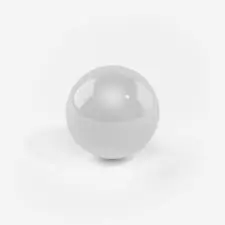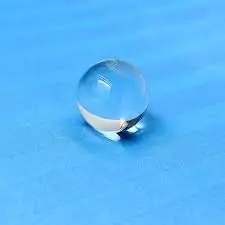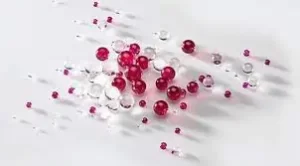In modern optics and precision engineering, few materials demonstrate the versatility and durability of sapphire balls. These high-precision components are manufactured from single-crystal aluminum oxide (Al₂O₃), also known as sapphire. With a hardness of 9 on the Mohs scale, sapphire is second only to diamond, making it ideal for demanding applications that require strength, chemical resistance, and optical clarity.
Sapphire balls are used across industries, ranging from aerospace and medical devices to laser systems and advanced optics. Their unique mechanical and optical properties have driven demand in both scientific research and industrial applications.

Physical and Mechanical Properties of Sapphire Balls
The performance of sapphire balls is primarily defined by the intrinsic properties of sapphire.
-
Hardness: Mohs hardness of 9 ensures resistance to scratching and wear.
-
Transparency: Excellent transmission from ultraviolet (UV) to mid-infrared (IR) regions, making sapphire optics superior to many glass alternatives.
-
Strength and Toughness: High compressive strength, withstanding extreme pressure environments.
-
Thermal Stability: Operating temperature range from −196 °C to over 1800 °C.
-
Chemical Resistance: Inert to acids, alkalis, and most corrosive environments.
These properties explain why sapphire balls outperform glass or ceramic in high-precision engineering applications.

Applications of Sapphire Balls
Sapphire balls are integral in a wide variety of industries. Below are some of the most significant applications:
1. Optical Systems and Sapphire Optics
Sapphire balls are frequently ground into sapphire spheres or hemispheres, serving as ball lenses in fiber-optic systems. Their ability to focus and collimate light makes them invaluable in laser coupling, barcode scanners, endoscopes, and optical communication systems.
In more complex sapphire optics, these balls may be polished into plano-convex micro lenses, providing transmission from 200 nm to 5000 nm. Combined with sapphire windows, they deliver superior durability in environments where conventional glass would fail.
2. Industrial Bearings and Precision Instruments
Because sapphire has exceptional wear resistance, sapphire spheres are used as bearings in flow meters, high-performance watches, and medical instruments. These components ensure long lifetimes, low friction, and precise rotation.
3. Medical Devices
In dialysis equipment, blood analyzers, and minimally invasive surgical tools, sapphire balls provide precise fluid control. Their non-magnetic and biocompatible nature makes them safe in medical applications.
4. Laser and Photonics
Sapphire spheres act as micro-lenses in laser focusing systems. Combined with sapphire crystal ball optics, they help control beam divergence, enabling applications in spectroscopy, laser surgery, and semiconductor manufacturing.
5. Aerospace and Defense
In aerospace gyroscopes, guidance systems, and extreme temperature sensors, sapphire balls and sapphire windows ensure performance where conventional materials would fail.

Manufacturing Process of Sapphire Balls
The production of sapphire balls involves advanced crystal growth and precision finishing techniques:
-
Crystal Growth
High-purity aluminum oxide is grown into large single crystals using methods such as the Verneuil or Kyropoulos process. -
Cutting and Rough Shaping
Sapphire boules are sliced into rough spheres or blanks. -
Precision Grinding
The blanks are shaped into near-perfect spheres using diamond grinding tools. -
Polishing
The surfaces are polished to achieve nanometer-level smoothness. This ensures optimal optical transmission for sapphire optics. -
Quality Control
Advanced metrology tools verify sphericity, diameter tolerance, and surface quality. Typical sapphire ball precision reaches Grade 25 (sphericity 0.625 µm).
Sapphire Balls vs. Other Materials
-
Compared to Glass Balls: Sapphire balls are harder, more durable, and offer better optical transmission in harsh environments.
-
Compared to Ruby Balls: While ruby (chromium-doped sapphire) offers similar hardness, sapphire balls provide better corrosion resistance and broader spectral transmission.
-
Compared to Ceramic Balls: Ceramics such as zirconia are less expensive, but sapphire spheres maintain superior optical clarity and chemical stability.
Market Trends and Industry Demand
The demand for sapphire balls and sapphire spheres is rising globally due to advancements in optics, photonics, and medical technology. The rapid growth of fiber-optic networks, high-precision measuring instruments, and semiconductor manufacturing is pushing the market forward.
Key market drivers include:
-
Expanding sapphire optics industry in telecommunications.
-
Growth in aerospace applications requiring sapphire windows and balls.
-
Increasing demand for sapphire crystal balls in scientific instrumentation and luxury applications.
Sapphire Crystal Ball: Scientific and Aesthetic Use
Although often associated with decorative or metaphysical markets, sapphire crystal balls also serve technical purposes. In optics, large sapphire spheres function as precision lenses or reference surfaces. Their clarity and durability make them superior alternatives to glass in specialized applications.
Integration with Sapphire Windows
When combined with sapphire windows, sapphire balls create a complete optical assembly. The windows provide protective shielding, while the balls focus or manipulate light. This integration is particularly useful in spectroscopy, medical imaging, and aerospace instrumentation.
Future Developments in Sapphire Balls
Innovations in nanotechnology and precision grinding continue to expand the capabilities of sapphire balls. Possible future directions include:
-
Integration with AR (anti-reflective) coatings for improved optical efficiency.
-
Micro-structured sapphire lenses for next-generation photonics.
-
Use in quantum optics and advanced metrology systems.
Frequently Asked Questions (FAQ)
Q1: What is a sapphire ball?
A sapphire ball is a precision sphere made from single-crystal aluminum oxide, valued for its hardness, durability, and optical transmission.
Q2: What are the main applications of sapphire balls?
They are used in optical systems, medical devices, aerospace components, precision bearings, and laser technology.
Q3: How are sapphire balls different from ruby balls?
Both are corundum, but sapphire offers better corrosion resistance and wider spectral transmission. Ruby balls contain chromium impurities, giving them a red color.
Q4: Can sapphire balls withstand high temperatures?
Yes, sapphire balls operate reliably from cryogenic conditions (−196 °C) up to 1800 °C.
Q5: What is the difference between sapphire spheres and sapphire crystal balls?
“Sapphire spheres” usually refer to precision industrial balls, while “sapphire crystal balls” may be used in optics, luxury goods, or aesthetic applications.
Conclusion
The sapphire ball is more than just a precision component—it is a cornerstone of modern optics, engineering, and medical technology. From sapphire optics and sapphire windows to advanced sapphire spheres and sapphire crystal balls, these components provide unmatched durability, clarity, and reliability.
As industries push the limits of performance in telecommunications, aerospace, photonics, and biomedical engineering, the demand for sapphire balls will continue to rise. Their role in shaping the future of precision technology is undeniable.
Sapphire windows sometimes is for medical use.
We also have medical furnitures for your needs.